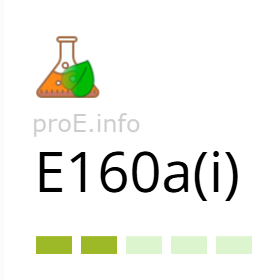
Other names for the additive (synonyms)
General Information
The food coloring additive E160a(i) – synthetic beta-carotene is an artificially produced analogue of the natural pigment that gives foods an orange hue. It belongs to the group of carotenoids (additive E160) and is a subtype of additive E160a. It is used in the food industry as a colorant.
Synthetic beta-carotene has a chemical structure identical to that of natural beta-carotene (additive E160a(ii)), but it is produced through chemical synthesis. It provides a stable and intense color, which makes it convenient for large-scale industrial use.
It is obtained by chemical synthesis in laboratory conditions, usually using acetylene or ionols.
Characteristics of additive E160a(i):
- Has a well-defined molecular structure – pure trans-beta-carotene.
- Does not contain other carotenoids.
- Bright orange powder or oily liquid.
The main advantages of E160a(i) include high stability and uniformity, as well as a controlled composition that facilitates standardized dosing.
Additive E160a(i) is used in margarines, oils, cheeses, confectionery products, beverages, and dietary supplements. Beta-carotene is also used in fortified foods as a provitamin A source.
For more information about the properties and effects of beta-carotene on human health, see the general descriptions of additives E160a and E160.